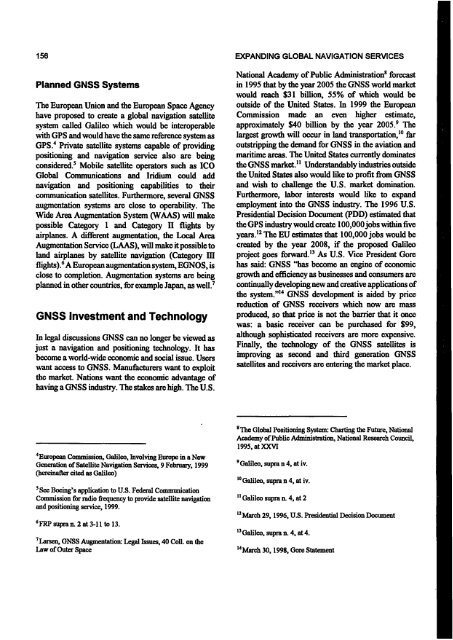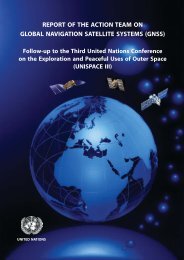Proceedings of the Workshop - United Nations Office for Outer ...
Proceedings of the Workshop - United Nations Office for Outer ...
Proceedings of the Workshop - United Nations Office for Outer ...
- No tags were found...
Create successful ePaper yourself
Turn your PDF publications into a flip-book with our unique Google optimized e-Paper software.
156 EXPANDING GLOBAL NAVIGATION SERVICESPlanned GNSS SystemsThe European Union and <strong>the</strong> European Space Agencyhave proposed to create a global navigation satellitesystem called Galileo which would be interoperablewith GPS and would have <strong>the</strong> same reference system asGPS.4 Private satellite systems capable <strong>of</strong> providingpositioning and navigation service also are beingconsidered.5 Mobile satellite operators such as ICOGlobal Communications and Iridium could addnavigation and positioning capabilities to <strong>the</strong>ircommunication satellites. Fur<strong>the</strong>rmore, several GNSSaugmentation systems are close to operability. TheWide Area Augmentation System (WAAS) will makepossible Category 1 and Category II flights byairplanes. A different augmentation, <strong>the</strong> Local AreaAugmentation Service (LAAS), will make it possible toland airplanes by satellite navigation (Category IIIflights).6 A European augmentation system, EGNOS, isclose to completion. Augmentation systems are beingplanned in o<strong>the</strong>r countries, <strong>for</strong> example Japan, as well.7GNSS Investment and TechnologyIn legal discussions GNSS can no longer be viewed asjust a navigation and positioning technology. It hasbecome a world-wide economic and social issue. Userswant access to GNSS. Manufacturers want to exploit<strong>the</strong> market. <strong>Nations</strong> want <strong>the</strong> economic advantage <strong>of</strong>having a GNSS industry. The stakes are high. The U.S.National Academy <strong>of</strong> Public Administration8 <strong>for</strong>ecastin 1995 that by <strong>the</strong> year 2005 <strong>the</strong> GNSS world marketwould reach $31 billion, 55% <strong>of</strong> which would beoutside <strong>of</strong> <strong>the</strong> <strong>United</strong> States. In 1999 <strong>the</strong> EuropeanCommission made an even higher estimate,approximately $40 billion by <strong>the</strong> year 2005.9 Thelargest growth will occur in land transportation,10 faroutstripping <strong>the</strong> demand <strong>for</strong> GNSS in <strong>the</strong> aviation andmaritime areas. The <strong>United</strong> States currently dominates<strong>the</strong> GNSS market.11 Understandably industries outside<strong>the</strong> <strong>United</strong> States also would like to pr<strong>of</strong>it from GNSSand wish to challenge <strong>the</strong> U.S. market domination.Fur<strong>the</strong>rmore, labor interests would like to expandemployment into <strong>the</strong> GNSS industry. The 1996 U.S.Presidential Decision Document (PDD) estimated that<strong>the</strong> GPS industry would create 100,000jobs within fiveyears.12 The EU estimates that 100,000 jobs would becreated by <strong>the</strong> year 2008, if <strong>the</strong> proposed Galileoproject goes <strong>for</strong>ward.13 As U.S. Vice President Gorehas said: GNSS “has become an engine <strong>of</strong> economicgrowth and efficiency as businesses and consumers arecontinually developing new and creative applications <strong>of</strong><strong>the</strong> system.”14 GNSS development is aided by pricereduction <strong>of</strong> GNSS receivers which now are massproduced, so that price is not <strong>the</strong> barrier that it oncewas: a basic receiver can be purchased <strong>for</strong> $99,although sophisticated receivers are more expensive.Finally, <strong>the</strong> technology <strong>of</strong> <strong>the</strong> GNSS satellites isimproving as second and third generation GNSSsatellites and receivers are entering <strong>the</strong> market place.4 European Commission, Galileo, Involving Europe in a NewGeneration <strong>of</strong> Satellite Navigation Services, 9 February, 1999(hereinafter cited as Galileo)5See Boeing’s application to U.S. Federal CommunicationCommission <strong>for</strong> radio frequency to provide satellite navigationand positioning service, 1999.6FRP supra n. 2 at 3-11 to 13.7Larsen, GNSS Augmentation: Legal Issues, 40 Coll. on <strong>the</strong>Law <strong>of</strong> <strong>Outer</strong> Space8 The Global Positioning System: Charting <strong>the</strong> Future, NationalAcademy <strong>of</strong> Public Administration, National Research Council,1995, at XXVI9Galileo, supra n 4, at iv.10 Galileo, supra n 4, at iv.11 Galileo supra n. 4, at 212 March 29, 1996, U.S. Presidential Decision Document13 Galileo, supra n. 4, at 4.14 March 30, 1998, Gore Statement
















